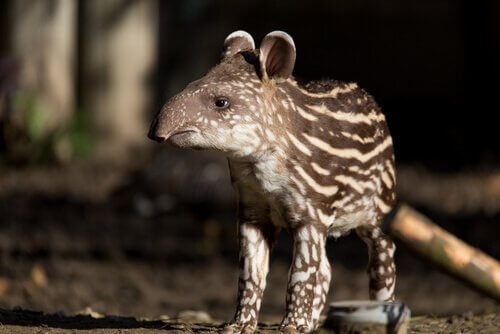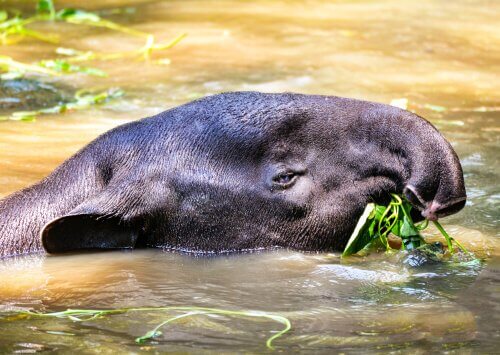The Brazilian Tapir: A Cousin to the Rhinoceros

The Brazilian tapir is an animal you’ll mostly see in Brazil, but its habitat covers most of the tropical forests in South America. They can range from the north of Argentina to Venezuela, but there are none in Chile nor anywhere west of the Andes mountains.
The word “tapir” comes from itapiré, an indigenous word that means a horn (piré) as hard as a rock (ita). In this case, the word is referring to their tough, hard skin. Some indigenous cultures, like the Mayans, considered them a sacred animal.
The habitat of the Brazilian tapir
These animals prefer mountains areas in tropical forests, but you can also find them in bogs and lowland forests. That means they live in places at sea level, and places as high as 15,000 feet above. They’re great mountain climbers and sometimes end up creating paths for large bodies of water.
Most tapirs like to be near the water. They especially like shallow rivers, although they’re also great swimmers. The highest population densities of Brazilian tapir are in areas with lots of vegetation and about 80-160 inches of rainfall each year.
The morphology of the Brazilian tapir
Adults can weight anywhere from 330 to 550 pounds. Their bodies can be up to 7.2 feet long in females and 6.7 feet in males. Their skulls have a large sagittal crest that runs from their eyes to their neck. They also have a little bit of hair that grows along the crest.
Adult tapirs are usually dark brown or reddish. Younger tapirs tend to be brown with horizontal white lines that disappear at seven months. This species has hooves and a very pronounced snout.

That snout is made entirely of soft tissue. It has even less bone and cartilage than other Ungulate animal species.
Reproduction
We still aren’t completely sure about their mating habits. What we do know is that females are sexually receptive, and that males fight for mating rights by biting each other’s hooves. Some people think they’re polygynous, which means the males can have more than one mate.
A Brazilian tapir pregnancy usually lasts about 380 days. Or, in other cases, it can be as short as 335 or as long as 439 days. Their cycles happen every 50-80 days and last 48 hours. Most females reach sexual maturity between 2-3 years old.
The oldest female Brazilian tapir ever documented giving birth in captivity was 28 years old. They can also reproduce at any point in the year. They only have one baby at a time, and they weigh about 6.6-13.2 pounds at birth. Weaning happens at 6-8 months, and most babies are independent by 18 months.
Behavior
The Brazilian tapir is generally solitary. While they’re not exclusively nocturnal, they do tend to hide in the forest during the day and go out foraging at night. You’ll often see them in pairs during the mating season, and when mothers are traveling with their children.
Brazilian tapirs have poor eyesight, but a strong sense of smell. They tend to be timid, but they’re also aggressive when fighting for a mate or defending their territory. Tapirs can make different sounds to express fear, anxiety, or pain.

They also make a variety of sounds during the mating season. They show aggression by snorting, and grunt when they’re irritated. Tapirs also use chemical forms of communication. For example, they urinate and use their facial glands to mark their territory.
Diet
The Brazilian tapir goes out looking for food at night. They eat fruits, leaves, and other vegetation. The things they most love, though, are yellow mombins, a kind of small plant that makes fruit similar to a plum.
They’re fruit-eaters and potential seed spreaders for some of the most important fruit trees in their habitat. Their digestion processes generally leave the entire seed intact.
People hunt this animal because their meat adds a lot of protein to the diets of the rural populations where they live. People have also domesticated them in Brazil, teaching them to plow and to let children climb on their backs.
Outside of humans, their main predator is the jaguar, though crocodiles can occasionally take them by surprise. Anytime a predator scares them, tapirs tend to flee to the water. On the other hand, if it feels trapped, a Brazilian tapir will run straight at its attacker.
All cited sources were thoroughly reviewed by our team to ensure their quality, reliability, currency, and validity. The bibliography of this article was considered reliable and of academic or scientific accuracy.
- https://www.tapirday.org/brazilian-tapir.html
This text is provided for informational purposes only and does not replace consultation with a professional. If in doubt, consult your specialist.